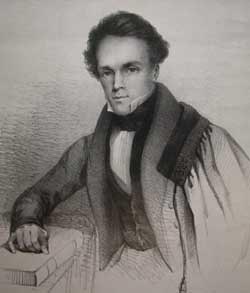|
NOTES
1
"Bennett, George," in
Dictionary of Australian Biography
by Angus and Robertson, 1949, BE-BO,
http://gutenberg.net.au/dictbiog/0-dict-biogBe-Bo.htmlt
;
"Bennett, George,"
http://www.anbg.gov.au/biography/bennett-george.html
2
"Review of New Publications,"
The Gentleman's Magazine (London, William Pickering), Vol. III New Series,
April, 1835, pg.
396.
Two insights the above gives us are that, per the reviewer's introduction, "a few"
dwarf potted trees were apparently in England (at
Windsor
Castle?) by the early 1830s, and, per the quote from the book,
a Englishman named Beale while living in the Macao/Canton area for at least 40 years had in
his possession several such trees for that length of time, i.e., since the 1790s. Whether
or not Beale actually cared for the trees himself is not known, but it is unlikely.
He probably had a native gardener -- who, with what prior experience, and what experiences afterwards?
"Mr. Beale" was the merchant
prince and opium mogul Thomas Beale. Living in China since 1792, he was
among the most respected British residents in Macao, equally well known among
the Chinese and Portuguese. His life dramatically illustrates the roller-coaster
course into which many an eastern merchant fell. While still a teenager, he came
to China to join his brother's trade business. Through guts, luck, and shrewdness,
he amassed enormous wealth, only to lose it and end up in debt. Tormented and
humiliated, he disappeared from his house one day in 1841. Weeks later, a few
Portuguese boys playing on the beach were shocked to discover a decomposed body half
buried in the sand. It was Thomas Beale, who had not seen England since his
departure five decades before.
In his active years, Beale was known for his
hospitality. His mansion in Macao included a splendid garden of
twenty-five hundred plants in pots, arranged in the Chinese fashion, and an even
more famous aviary, a must-see for Western visitors to Macao. The aviary,
forty by twenty feet, contained hundreds of rare birds from China, Europe,
Southeast Asia, and South America. George Vachell, the chaplain to the
China Factory, described the sight in detail to his friend John Henslow,
Professor of Botany at Cambridge University and mentor to Charles Darwin.
There were about six hundred birds in the aviary at the time of Vachell's visit.
When the naturalist George Bennett (above) stopped in Macao during his Pacific voyage, he
was so impressed with Beale's garden and aviary that he devoted forty-five pages
of his travelogue to describing their contents. (Per Fan, Fa-ti
British Naturalists in Qing China: Science, Empire, and Cultural Encounter
(Cambridge, MA and London: Harvard University Press; 2004), pp. 44-45. A
short bio on pg. 163 lists Beale's dates as c.1775-1842.)
This excerpt from Bennett thus puts
Livingstone's
report and those of
Fortune
in an entirely different light.
It would be interesting to speculate on what background the
reviewer(s) had to make the comment on Bennett's account "though not so full as we could have wished"
-- what additional details, techniques and processes might the reviewer have wanted from this early
historically-detailed-for-its-time report?
3
The Monthly Review (London: John Murray), Vol. III, No. III, November 1834, beginning on pg. 396, with mention of dwarf trees on pg.
410.
Another review can be found in
The Quarterly Review (London: John Murray), Vol. LIII, No. CVI, February 1835, pg.
18, with an
excerpted version in the American edition out of New York, The London Quarterly Review, pg.
10.
|

